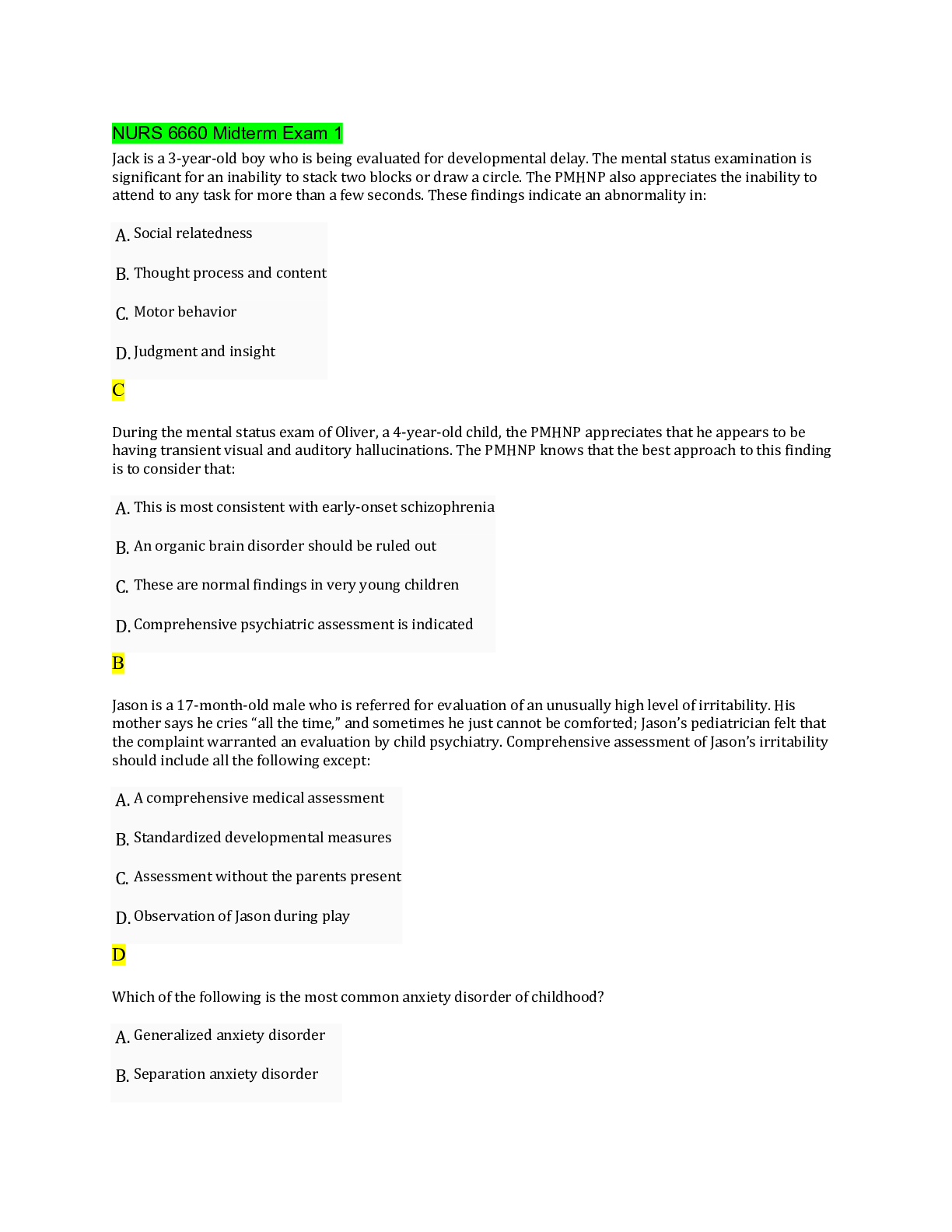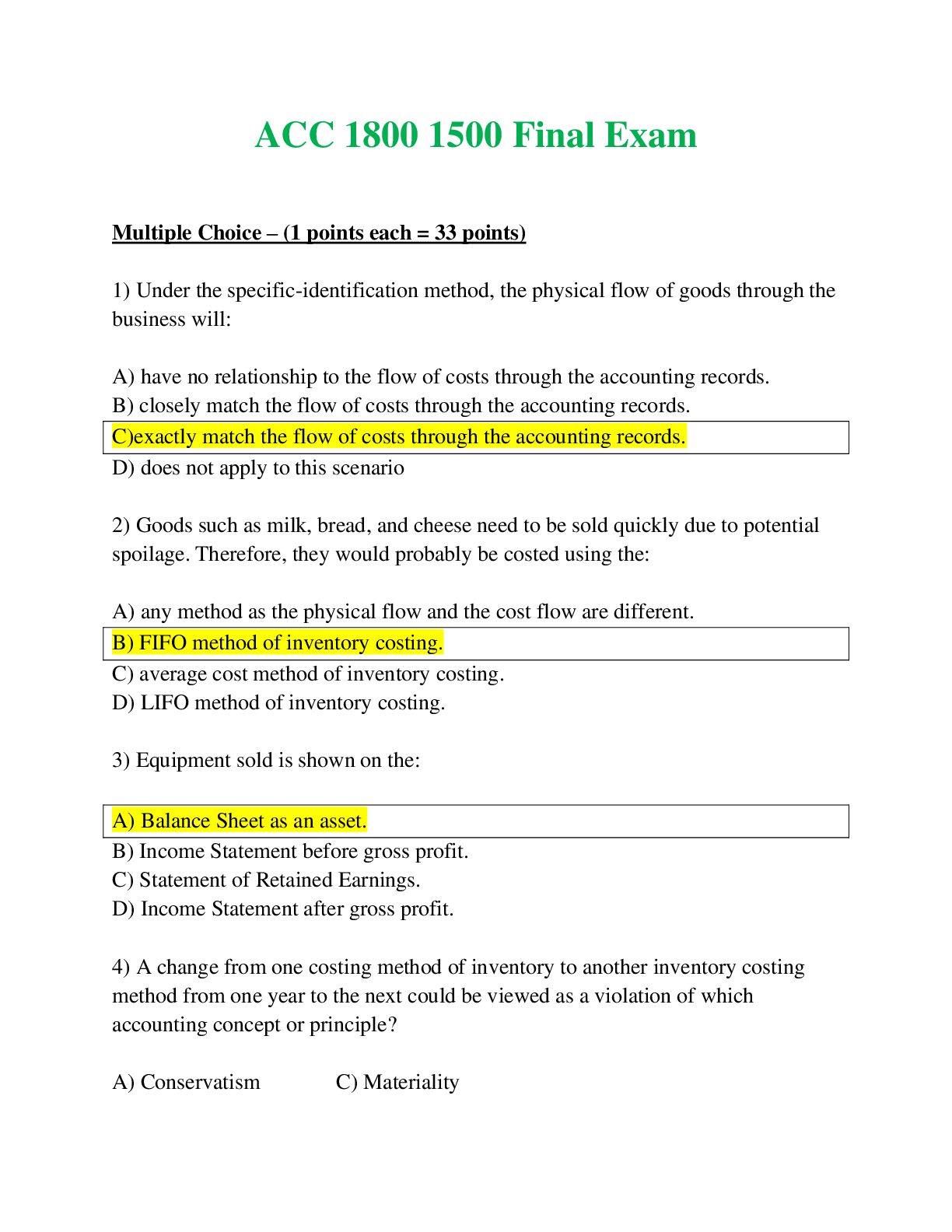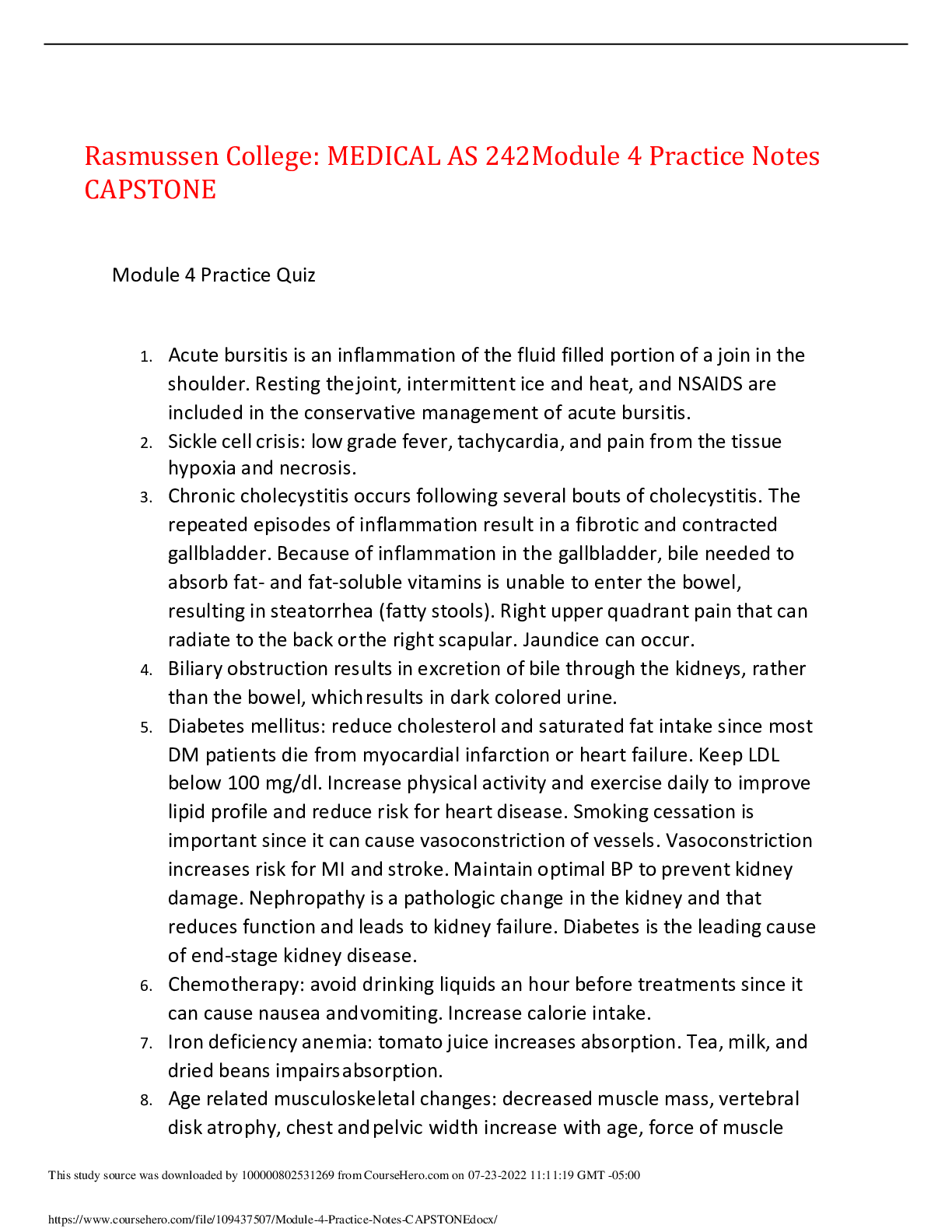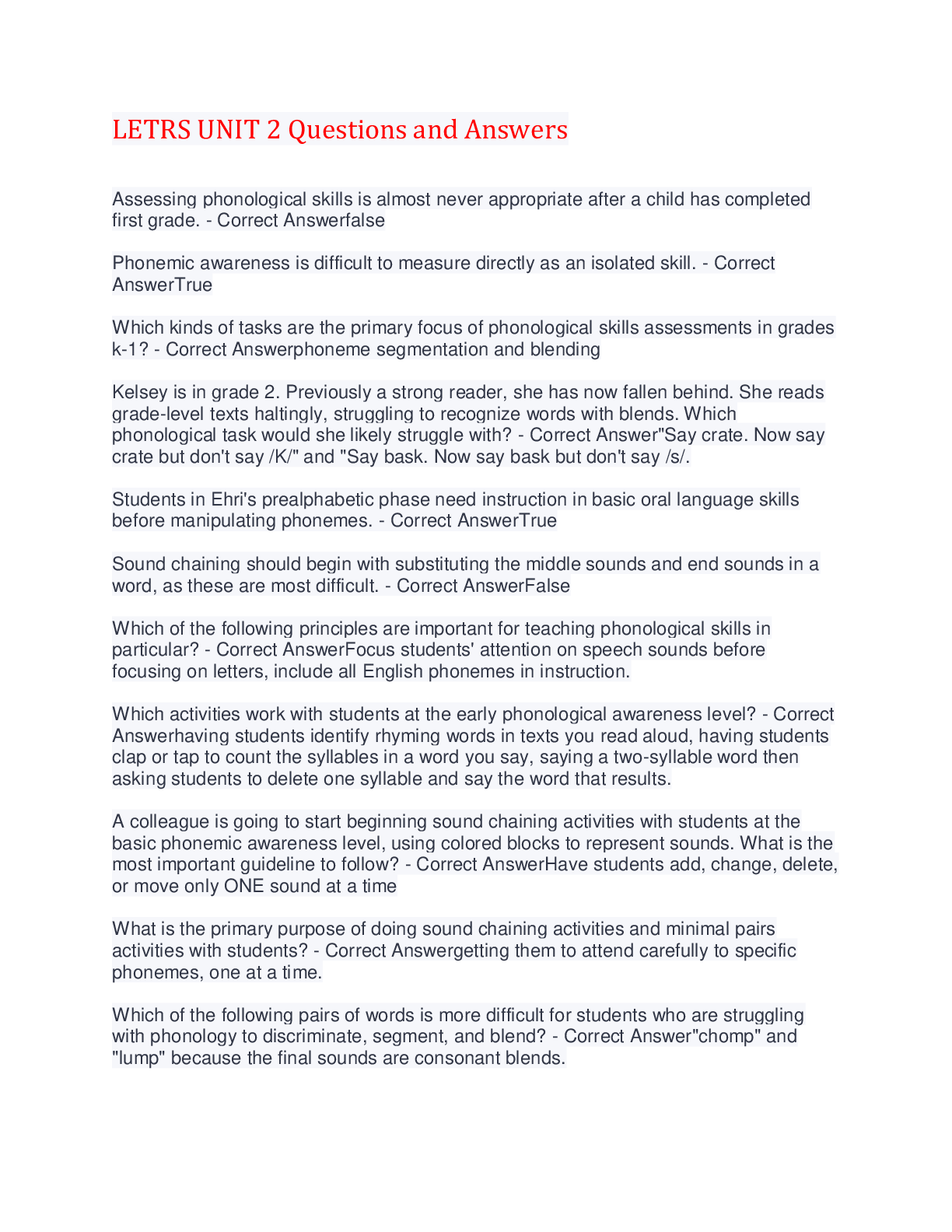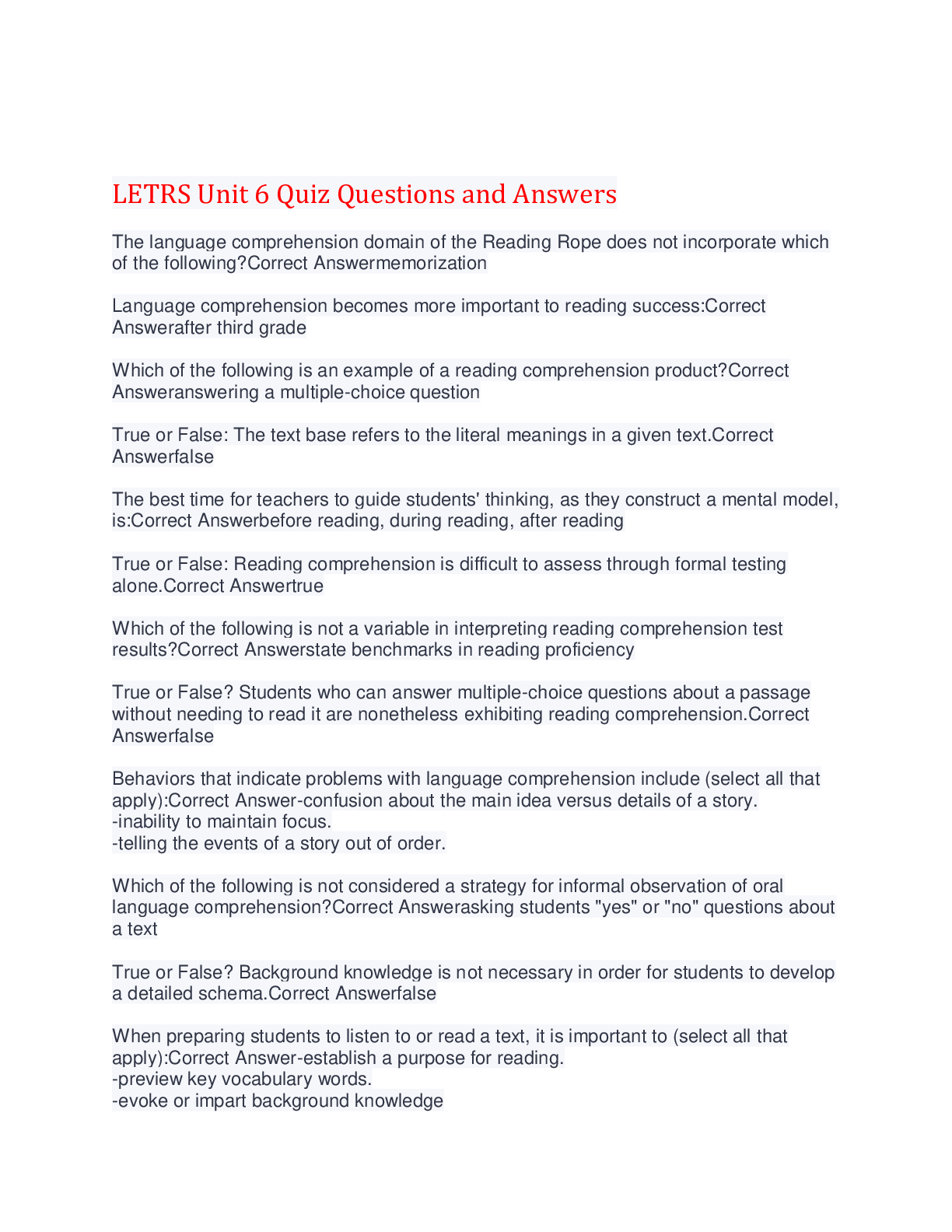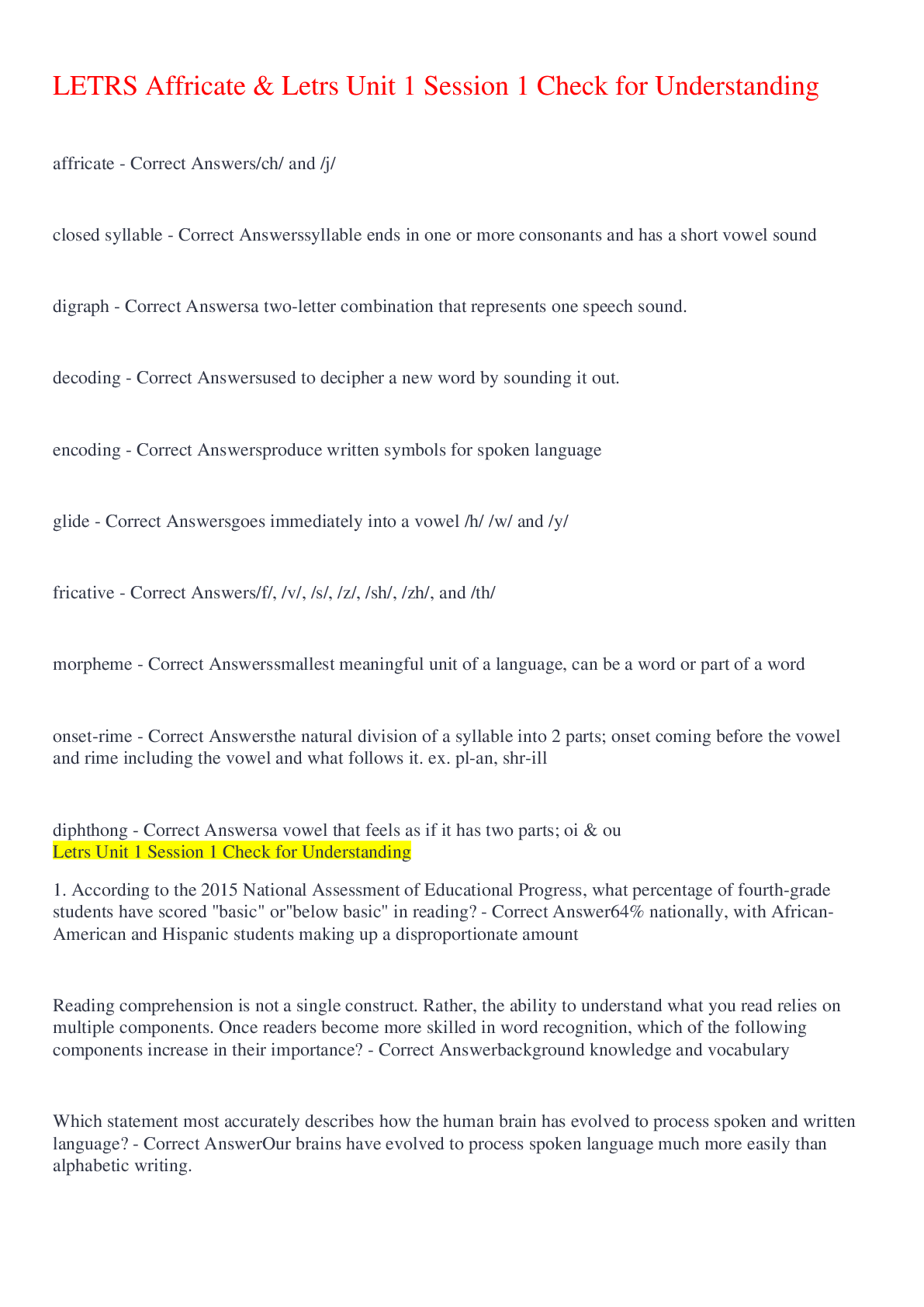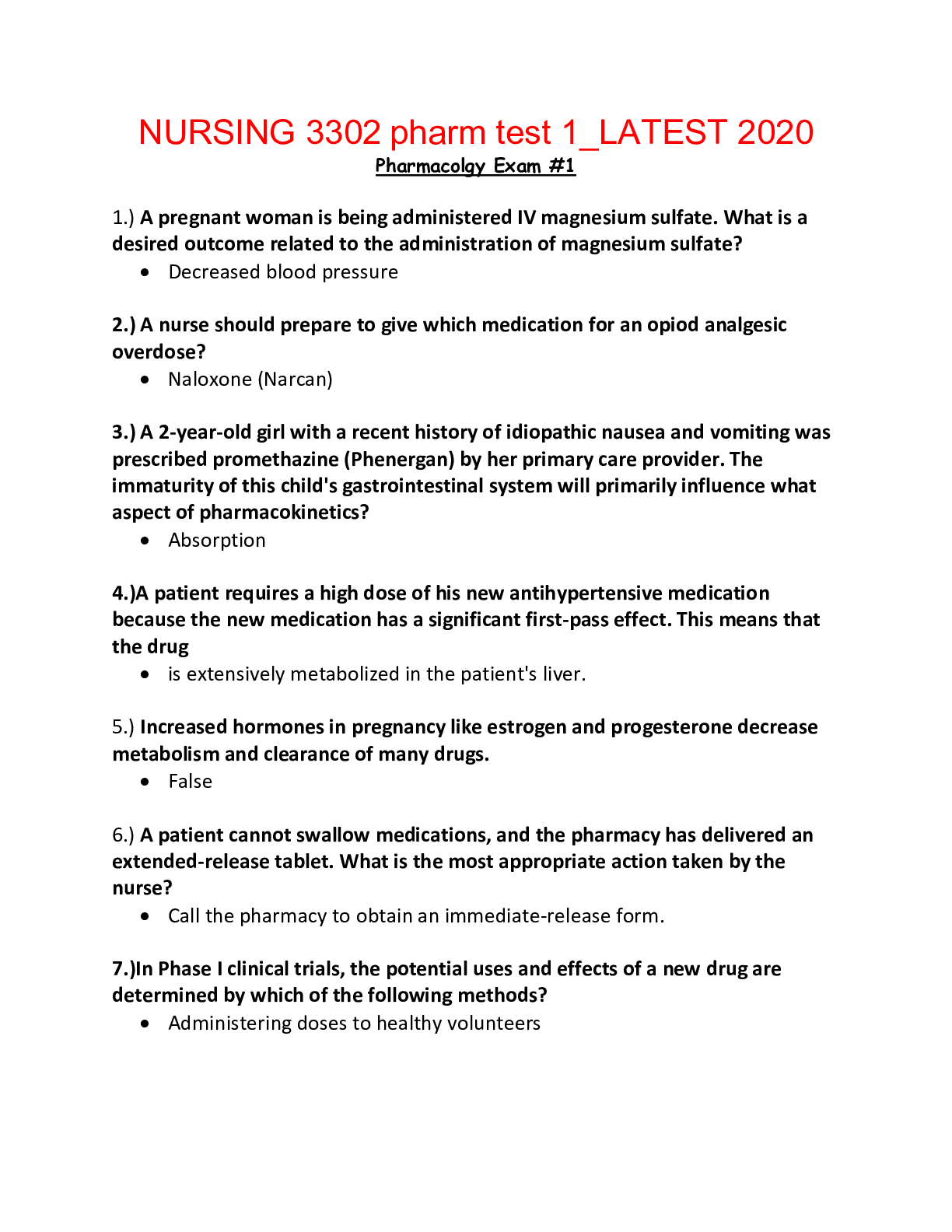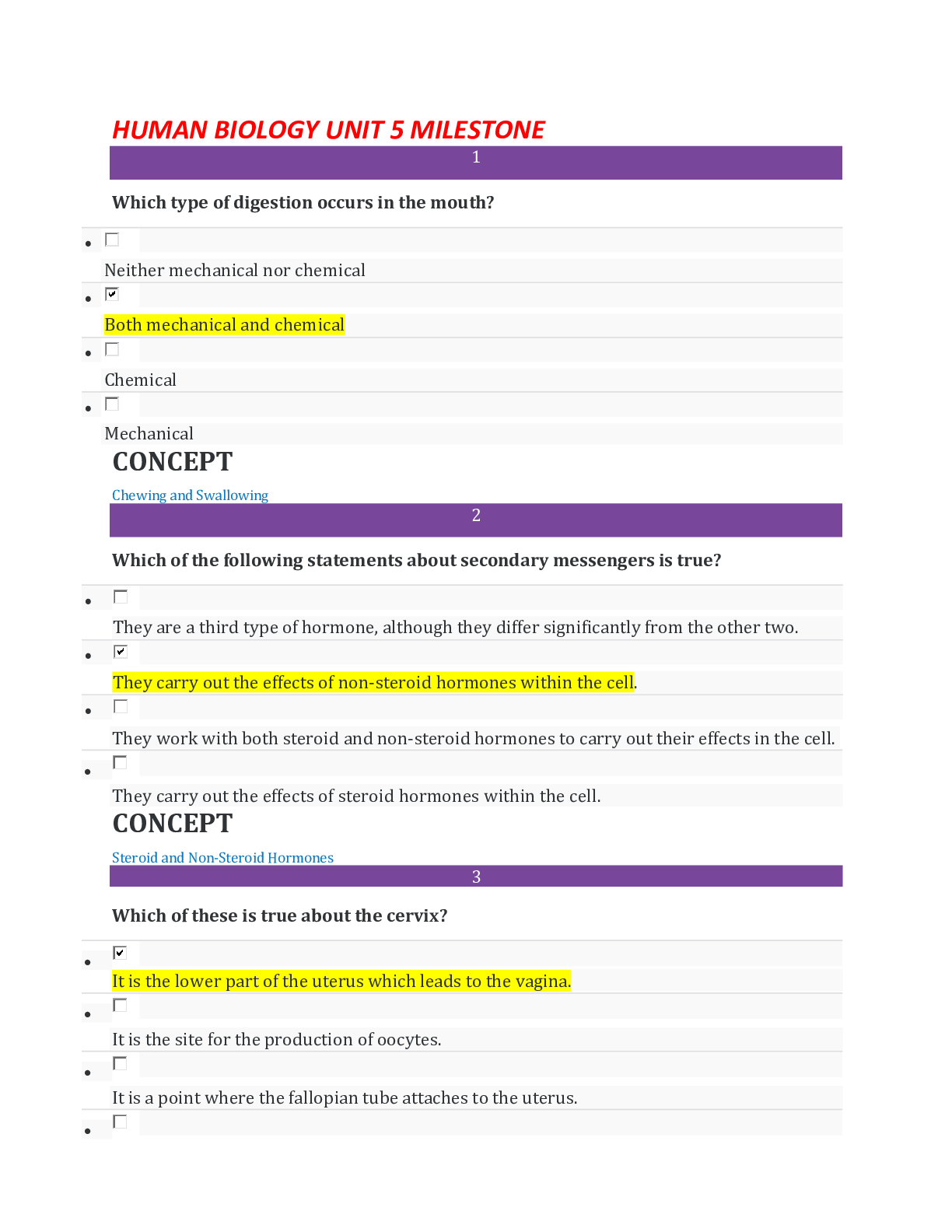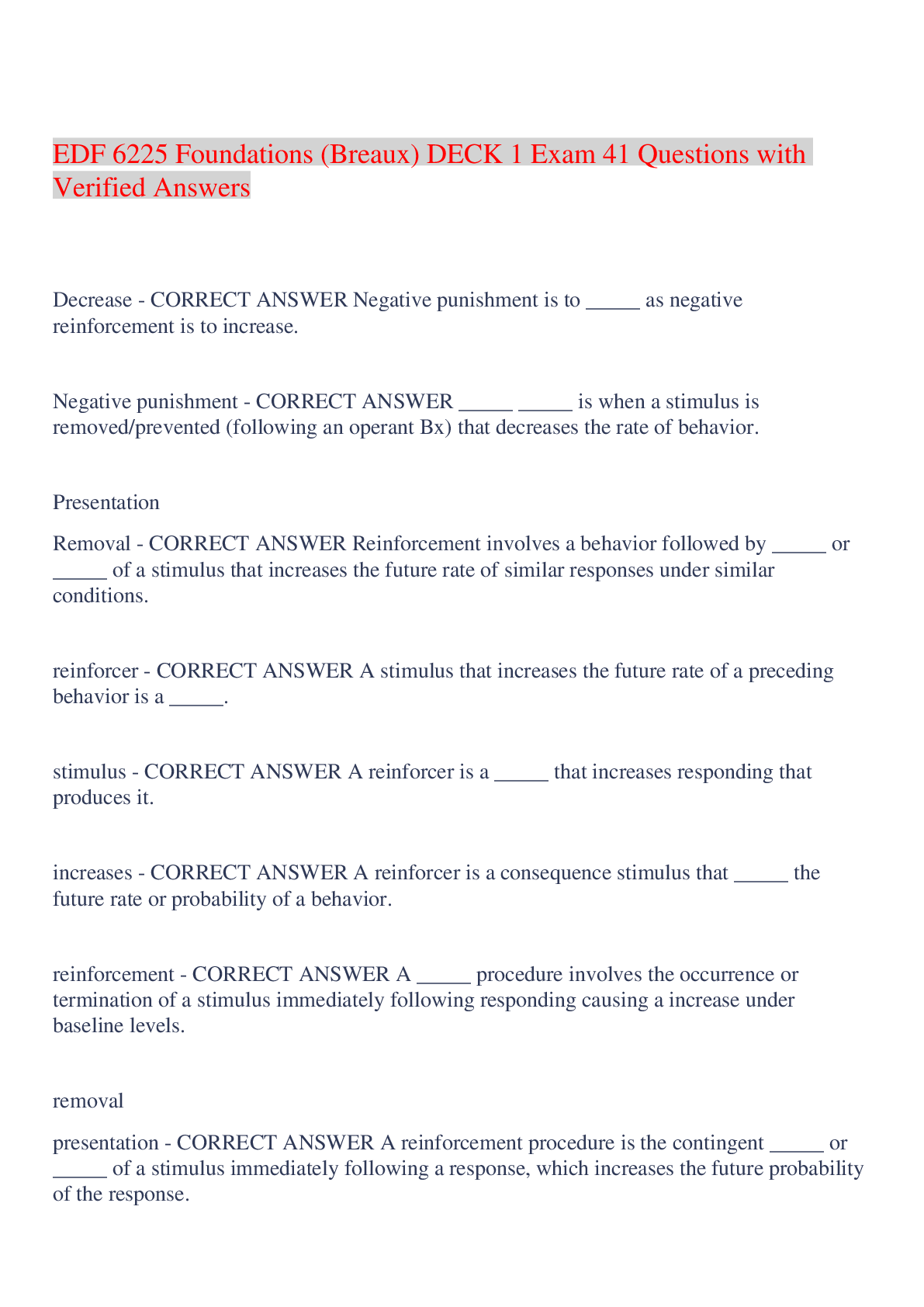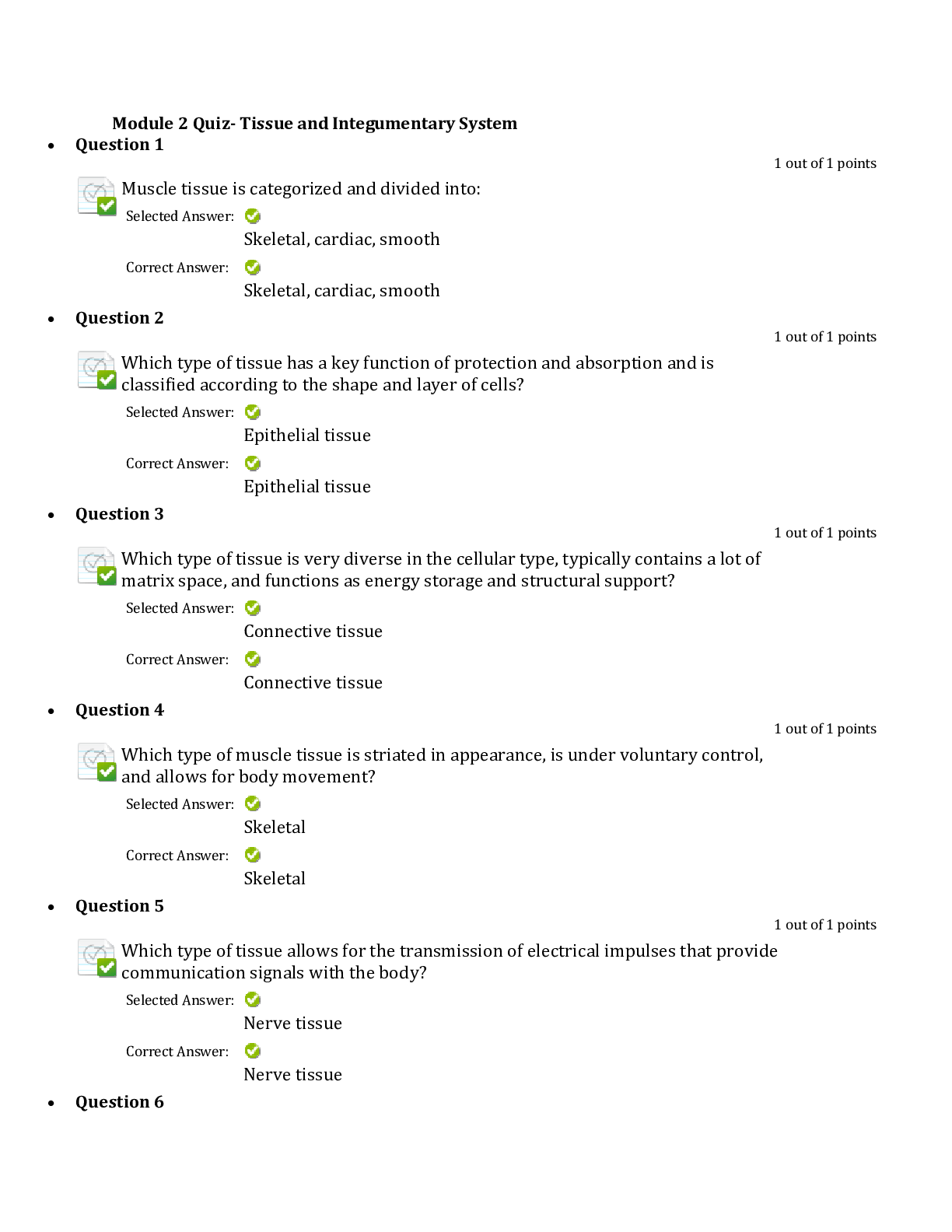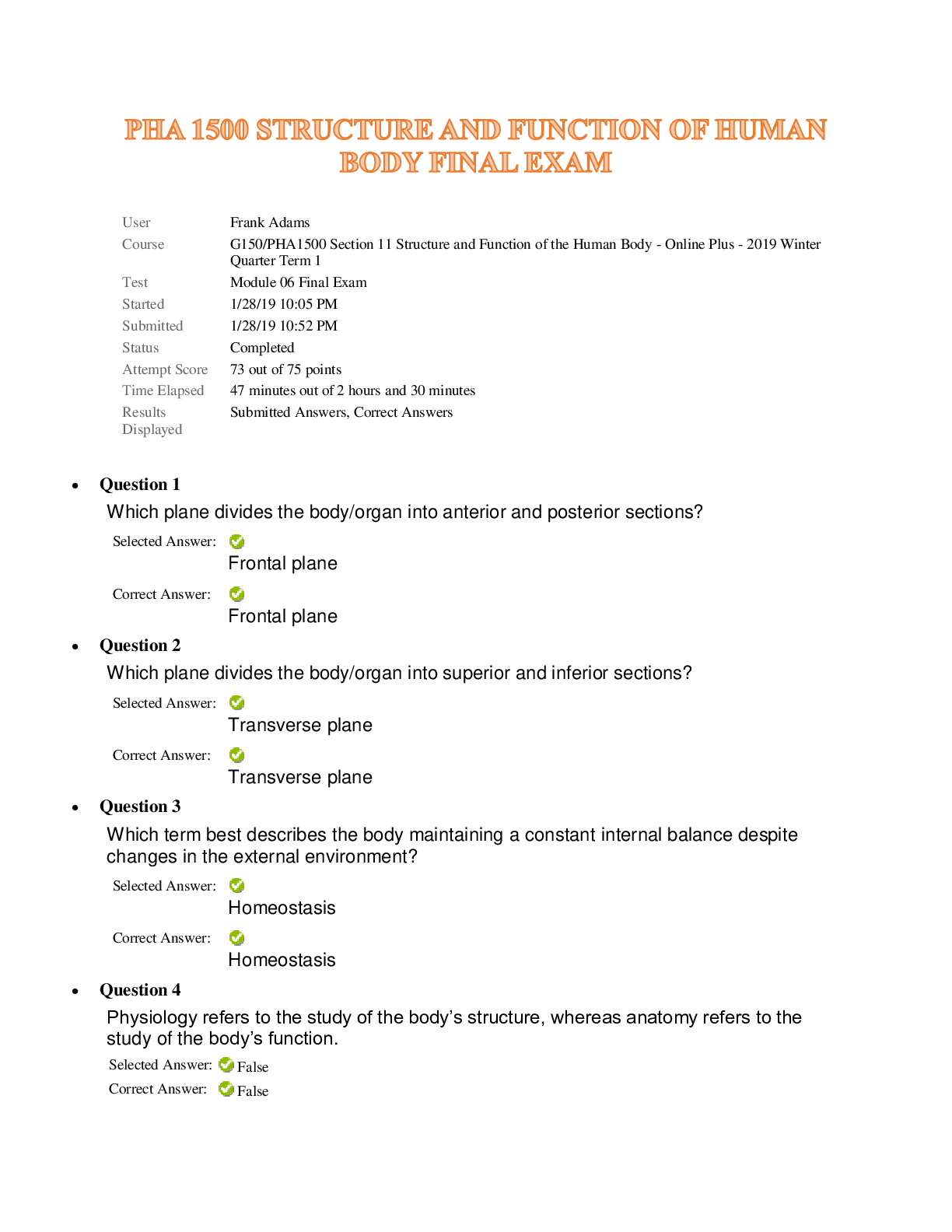*NURSING > EXAM > NURS 8022 Structure and Function of the Digestive System Huether & McCance: Understanding Pathophysi (All)
NURS 8022 Structure and Function of the Digestive System Huether & McCance: Understanding Pathophysiology, 6th Edition,100% CORRECT
Document Content and Description Below
NURS 8022 Structure and Function of the Digestive System Huether & McCance: Understanding Pathophysiology, 6th Edition MULTIPLE CHOICE 1. Digestion begins in the mouth with salivary -amylas... e (ptyalin) that initiates the digestion of: a. proteins. b. carbohydrates. c. fats. d. amino acids. ANS: B Salivary amylase initiates the digestion of carbohydrates. Protein digestion occurs in the stomach and is influenced by pepsin. Fat digestion is aided by bile. Amino acids are not involved in the digestive process. REF: p. 886 2. When parasympathetic nervous system activity is inhibited what is the expected effect on salivary glands? a. Hyperactive function b. Hypoactive function c. Atrophy d. Enlargement ANS: B Inhibition of the parasympathetic nervous system would result in decreased (hypoactive) functions of the salivary glands. The individual would experience dry mouth. Inhibition of the parasympathetic nervous system would not result in hyperactivity, atrophy, or enlargement of the salivary glands. REF: p. 886 3. Which immunoglobulin is found in normal saliva? a. IgG b. IgD c. IgE d. IgA ANS: D Normal saliva contains IgA. Normal saliva does not contain IgG, IgD, or IgE. REF: p. 886 4. Food is moved down the esophagus via what process? a. Peristalsis b. Retropulsion c. Haustral segmentation d. Defecation ANS: A Swallowed food is moved from the esophagus to the stomach by peristalsis, not retropulsion. Haustral segmentation occurs in the small intestine. Defecation is the process of eliminating stool from the rectum. REF: p. 886 5. Which cells of the gastric glands secrete hydrochloric acid? a. Chief b. Parietal c. Zymogenic d. Surface epithelial ANS: B The parietal cells secrete hydrochloric acid. The chief cells secrete pepsinogen. Zymogenic cells do not secrete acid. Epithelial cells line the GI tract and do not secrete acid. REF: p. 888 6. A young male student becomes very hungry during class. He begins thinking of a cheeseburger and fries, his favorite meal. These thoughts will trigger which phase of gastric secretion? a. Cephalic b. Gastric c. Enteral d. Intestinal ANS: A The cephalic phase is stimulated by the thought, smell, and taste of food. The gastric phase is stimulated by distention of the stomach. The enteral phase is not a phase of gastric secretion. The intestinal phase is stimulated by histamine and digested protein. REF: p. 888 7. Mucus production to form the mucosal barrier in the stomach is stimulated by the release of: a. somatostatin. b. gastrin. c. prostaglandins. d. histamine. ANS: C Prostaglandins protect the mucosal barrier by stimulating the secretion of mucus and bicarbonate and by inhibiting secretion of acid. Somatostatin is secreted by the pancreas and is not involved in secretion of mucus. Gastrin is not involved in mucus secretion. Histamine initiates secretion of acid, not mucus. REF: p. 889 8. Which sphincter prevents reflux of digested material from the colon into the small intestine? a. Haustral b. Lower esophageal c. Pyloric d. Ileocecal valve ANS: D The ileocecal valve prevents reflux of digested material from the colon into the small intestine. The haustral segments facilitate propulsion; they do not prevent reflux. Lower esophageal prevents reflux from the stomach to the esophagus. The pylorus is the opening between the stomach and the duodenum. REF: p. 890 9. Absorption of nutrients from the intestine occurs initially through the: a. mesentery. b. villi. c. lamina propria. d. splenic veins. ANS: B Villi are small finger-like projections that extend from the small intestinal mucosa and increase its absorptive surface area. The ileum and jejunum are suspended in loose folds from the posterior abdominal wall by a peritoneal membrane called the mesentery. The lamina propria (a connective tissue layer of the mucous membrane) lies beneath the epithelial cells of the villi and contains lymphocytes and plasma cells, which produce immunoglobulins. The splenic vein drains the stomach and is not involved in absorption. REF: p. 890 10. Which reflex inhibits gastric motility when the ileum becomes overdistended? a. Ileogastric b. Gastroduodenal c. Gastroileal d. Gastrocolic ANS: A The ileogastric reflex, not the gastroduodenal, inhibits gastric motility when the ileum becomes distended. The gastroileal reflex, which is activated by an increase in gastric motility and secretion, stimulates an increase in ileal motility and relaxation of the ileocecal valve (sphincter). The gastrocolic reflex initiates propulsion in the entire colon, usually during or immediately after eating, when chyme enters from the ileum. REF: p. 893 11. The vermiform appendix is attached to the: a. duodenum. b. ileum. c. cecum. d. sigmoid colon. ANS: C The vermiform appendix is attached to the cecum. The vermiform appendix is not attached to the duodenum, the ileum, or the sigmoid. REF: p. 894 12. The sphincter controls the movement of waste from the sigmoid colon into the rectum? a. oddi b. ileocecal c. O’Beirne d. internal anal ANS: C The O’Beirne sphincter controls the movement of wastes from the sigmoid colon into the rectum. None of the other options performs this function. REF: p. 894 13. The reflex initiates propulsion in the entire colon, usually during or immediately after eating. a. gastrocolic b. ileocolic c. duodenocolic d. cephalocolic ANS: A The gastrocolic reflex initiates propulsion in the entire colon. None of the other options performs this function. REF: p. 894 14. The blood supply of the large intestine is derived from which vessel(s)? a. Celiac b. Superior and inferior mesenteric c. Hepatic and portal d. Omental ANS: B The blood supply of the large intestine and rectum is derived primarily from branches of the superior and inferior mesenteric arteries. None of the other options performs this function. REF: p. 894 15. The capillaries of the liver are more commonly known as hepatic: a. canaliculi. b. ducts. c. sinusoids. d. papillae. ANS: C Small capillaries, or sinusoids, are located between the plates of hepatocytes of the liver. None of the other options presents an appropriate term. REF: p. 896 16. Which of the following liver cells are phagocytic? a. Glisson b. Kupffer c. Meissner d. Lieberkühn ANS: B The sinusoids are also lined with phagocytic Kupffer cells and are part of the mononuclear phagocyte system. The Glisson is the capsule that covers the liver. The Meissner is a part of the nerve plexus that innervates the liver. The Lieberkühn is a part of the liver’s secretory cells. REF: p. 896 17. The primary bile salts are synthesized from by hepatocytes lining the bile canaliculi. a. lecithin b. fatty acids c. cholesterol d. testosterone ANS: C Bile acids (salts) are synthesized from cholesterol. The process is not reliant on lecithin, fatty acids, or testosterone. REF: p. 897 18. In the liver, free bilirubin moves from the plasma in the sinusoids into the hepatocytes, where it is converted into: a. unconjugated bilirubin. b. biliverdin. c. conjugated bilirubin. d. urobilinogen. ANS: C Within hepatocytes, unconjugated bilirubin joins with glucuronic acid to form conjugated bilirubin, not unconjugated, which is water soluble and is secreted in the bile. Biliverdin is a precursor of bilirubin. When conjugated bilirubin reaches the distal ileum and colon, it is deconjugated by bacteria and converted to urobilinogen. REF: p. 898 19. Which information indicates the nurse understands digestion? During the cephalic and gastric phases of digestion, gallbladder contraction is mediated by branches of the: a. sympathetic nervous system. b. somatic nervous system. c. vagus nerve. d. glossopharyngeal nerve. ANS: C Gallbladder contraction is mediated by cholinergic branches of the vagus nerve, not the sympathetic nervous system. Gallbladder contraction is not mediated by the somatic or glossopharyngeal nerves. REF: p. 901 20. Which sphincter, when it relaxes, allows bile to flow into the duodenum? a. Pyloric sphincter b. Sphincter of Oddi c. Ampulla of Vater d. Ileocecal valve ANS: B When the sphincter of Oddi relaxes, bile flows into the duodenum. The pyloric sphincter controls flow of fluid from the stomach to the duodenum. Secretions from the pancreas empty into the common bile duct at the ampulla of Vater. The ileocecal valve prevents reflux of digested material from the colon into the small intestine. REF: p. 901 21. The exocrine portion of the pancreas contains: a. alpha cells. b. beta cells. c. acinar cells. d. islets of Langerhans. ANS: C The exocrine portion of the pancreas contains acinar cells. It is the endocrine portion that contains the alpha and beta cells as well as the islets of Langerhans. REF: p. 902 22. The function of the acinar cells of the pancreas is to secrete: a. bicarbonate. b. enzymes. c. mucus. d. electrolytes. ANS: B The exocrine pancreas is composed of acinar cells that secrete enzymes. These cells are not associated with bicarbonate, mucus, or electrolytes. REF: p. 902 23. Parasympathetic stimulation to the pancreas will cause which of the following reactions? a. Hormonal inhibition b. Enzyme secretion c. Vasoconstriction d. Decreased bicarbonate production ANS: B Pancreatic innervation arises from preganglionic parasympathetic fibers of the vagus nerve. These fibers activate postganglionic fibers, which stimulate enzymatic and hormonal secretion. Pancreatic innervations stimulate hormone secretion, not inhibit it. Sympathetic postganglionic fibers from the celiac and superior mesenteric plexuses innervate the blood vessels, cause vasoconstriction, and inhibit pancreatic secretion. Parasympathetic stimulation is not involved in bicarbonate production. REF: p. 902 24. The pancreas produces which substance to prevent the premature activation of proteolytic enzymes in the pancreas? a. Bicarbonate b. Carboxypeptidase c. Secretin d. Trypsin inhibitor ANS: D The pancreas produces trypsin inhibitor, which prevents the activation of proteolytic enzymes while they are in the pancreas. Bicarbonate is responsible for neutralizing fluid. Carboxypeptidase is a protein-digesting enzyme. Secretin is not produced by the pancreas. REF: p. 902 MULTIPLE RESPONSE 1. The GI tract performs which of the following processes? (select all that apply) a. Absorption of digested food b. Chemical breakdown of food particles c. Initiates erythropoiesis d. Mechanical breakdown of food particles e. Secretion of mucus ANS: A, B, D, E The GI tract carries out the following processes: (i) ingestion of food; (ii) propulsion of food and wastes from the mouth to the anus; (iii) secretion of mucus, water, and enzymes; (iv) mechanical digestion of food particles; (v) chemical digestion of food particles; (vi) absorption of digested food; and (vii) elimination of waste products by defecation. REF: p. 884 [Show More]
Last updated: 2 years ago
Preview 1 out of 13 pages
.png)
Buy this document to get the full access instantly
Instant Download Access after purchase
Buy NowInstant download
We Accept:

Reviews( 0 )
$15.00
Can't find what you want? Try our AI powered Search
Document information
Connected school, study & course
About the document
Uploaded On
May 22, 2021
Number of pages
13
Written in
Additional information
This document has been written for:
Uploaded
May 22, 2021
Downloads
0
Views
72


